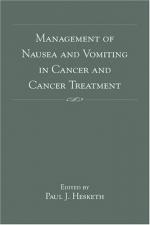|
This section contains 391 words (approx. 2 pages at 300 words per page) |
Nausea refers to the unpleasant sensation in the stomach that is usually accompanied by the urge to vomit.
The process of nausea is regulated in the brain by the chemoreceptor trigger zone, which is in an area of the medulla known as the vomiting center. The chemoreceptor trigger zone senses metabolic abnormalities that are contributing to stomach upset, such as toxins in the body, and stimulates the vomiting center. Once stimulated, the center directs the release of several neurotranmitters that drive the physical processes of vomiting; the forceful expulsion of the stomach contents.
Nausea itself is associated with several physiological processes. The contents of the stomach move less and contents of the intestine can flow back into the stomach. The intestine becomes more rigid, which restricts the passage of digested material down its length. The desire to eat disappears. A headache can develop and both perspiration and salivation increase. Finally, the windpipe (trachea) closes and the abdominal wall and the diaphragm muscles tighten quickly. The forceful squeezing of the stomach, combined with the upward pressure on the stomach from the intestinal tract, ejects the stomach contents up the esophagus and out of the mouth in the act of vomiting.
There are a variety of causes of nausea. For example, intense pain, such as often occurs from a migraine headache can be a trigger. Drugs, such as those used in chemotherapy, may also act as a triggering mechanism. Metabolic disorders also can be a factor. An example is the acidification of the blood that can occur in diabetes. The presence of toxins and other contaminants may also contribute to nausea symptoms. Nausea-inducing physiological changes can occur as a result of rapid hormonal shifts in the early weeks of pregnancy, from sea or other motion sickness, and from emotional stress.
In the case of food poisoning or the presence of other toxins, nausea is a beneficial response, allowing the body to purge itself of the offending agent. However, in other instances control of nausea is sought (for example, when nausea is a side effect of chemotherapy). Management of nausea via drugs can increase the well being of the patient during therapy and contribute to a patient's willingness to undergo therapy. Various chemicals can act as palliatives and alleviate the feelings of nausea, by blocking various receptors in the chemoreceptor trigger zone.
|
This section contains 391 words (approx. 2 pages at 300 words per page) |


